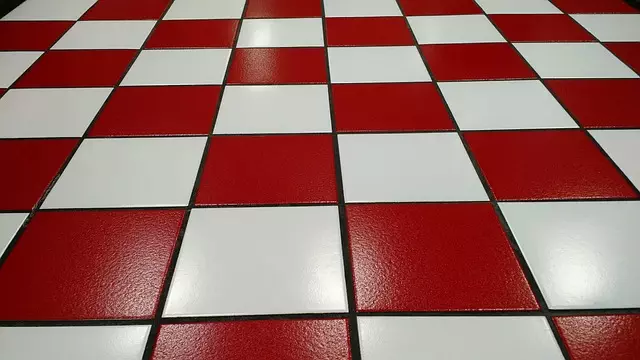Removing stains from grout lines requires understanding their causes, such as water damage, mold buildup, dirt accumulation, and improper cleaning methods. Prepare by sweeping, mixing a solution of warm water and mild detergent, and gently scrubbing the stained grout with a soft-bristled brush. Use stain-specific cleaning products designed for grout, following manufacturer instructions carefully. Regular maintenance like prompt spill cleanup and routine deep cleaning prevents new stains. Strategies include using circular motions to lift stains, specialized cleaners, steaming, or a grout brush. Prioritize safety and conduct patch tests before applying cleaners. Regular sweeping, vacuuming, and mild detergent cleaning prevent persistent stains. Natural solutions like baking soda and vinegar can also be effective.
Tired of unsightly grout stains marring your once-pristine tiles? Discover the secrets to high-quality grout stain removal with our comprehensive guide. We’ll walk you through understanding common stain causes, preparing your space for optimal cleaning, and selecting the best products for the job. Learn effective techniques to tackle even persistent stains, along with essential safety measures and maintenance tips to keep your grout lines looking fresh long-term—all tailored to help you remove stains from grout lines effortlessly.
Understanding Grout Stain Causes

Grout stain removal can be a challenging task, but understanding the causes behind these stains is the first step towards achieving high-quality results. Grout lines, often found in bathrooms and kitchens, are susceptible to staining due to their porous nature and exposure to various substances. Common causes of grout stains include water damage, mold and mildew buildup, dirt and grime accumulation, and even improper cleaning methods.
Water is a primary culprit, as it can leave behind minerals and moisture, creating the perfect environment for bacteria and mold growth. Over time, these organisms produce stains that can be challenging to remove. Additionally, everyday activities like cooking, showering, or simply stepping in the grout can introduce dirt, oils, and other contaminants, leading to unsightly discolourations. Identifying the specific cause of the stain is crucial when developing an effective cleaning strategy for removing stains from grout lines.
Preparation for Stain Removal

Before tackling any stain removal process, proper preparation is key. For removing stains from grout lines, start by sweeping or vacuuming the floor to eliminate any loose debris. Next, mix a solution of warm water and mild detergent – a simple, yet effective cleaning mixture. Test this solution on a small, inconspicuous area first to ensure it won’t damage or discolor the grout. This step is crucial to avoid any unintended consequences.
Once you’ve confirmed the safety of your cleaning agent, apply the solution liberally to the stained grout lines. Use a soft-bristled brush to gently scrub away at the stain, applying consistent but gentle pressure. Regularly rinse the brush in clean water to prevent redepositing dirt and debris on the freshly cleaned grout.
Choosing the Right Cleaning Products

When it comes to removing stains from grout lines, choosing the right cleaning products is paramount. Start by identifying the type and severity of the stain—from everyday dirt and grime to tough, ingrained residue—to select a cleaner tailored for that specific challenge. Many effective grout cleaners are designed to dissolve stubborn mold, mildew, or mineral deposits without damaging the grout or surrounding tiles.
Opt for a product that combines powerful cleaning agents with safe, non-toxic ingredients, especially in areas prone to foot traffic or near sources of water. Always follow the manufacturer’s instructions and safety guidelines when using any cleaner, ensuring proper ventilation and wearing protective gear if necessary. Regular maintenance, including prompt wiping down of spills and routine deep cleaning, can significantly prevent new grout stains from forming.
Effective Cleaning Techniques

Removing stains from grout lines requires a systematic approach and the right tools to achieve optimal results. Start by vacuuming or brushing away any loose debris or dust trapped within the grout. This initial step ensures a cleaner playing field for your stain removal efforts. Next, prepare a cleaning solution using a mild detergent and warm water, avoiding harsh chemicals that could damage the grout material.
Apply the solution using a soft-bristled brush or a microfiber cloth, gently rubbing in circular motions to loosen and lift stains from the grout lines. For more stubborn stains, consider using specialized grout cleaners designed to penetrate and break down organic compounds. Always test any cleaning agent on a small, discreet area first to ensure it won’t discolor or damage the grout’s finish.
Dealing with Persistent Stains

When it comes to removing grout stains, persistence is key. If initial cleaning attempts don’t yield the desired results, it might be a sign that the stain has set in deep. In such cases, stronger, specialized cleaning agents might be necessary. There are various enzymatic or acid-based cleaners designed specifically for tackling tough grout stains. These powerful solutions can break down and remove organic compounds and mineral deposits that have caused the discoloration.
However, it’s crucial to exercise caution when using these aggressive cleaning products, as they can damage tile surfaces if not used properly. Always follow the manufacturer’s instructions and test a small, hidden area first. For stubborn stains in between tiles, consider steaming or using a grout brush to apply cleaner directly into the lines. This targeted approach ensures that every corner and crevice is treated, maximizing your chances of successfully removing even the most persistent grout stains.
Safety Measures and Precautions

When tackling grout stain removal, safety should be your top priority. Always wear protective gear, including gloves and goggles, to shield yourself from potential chemicals and debris. Ensure adequate ventilation in the workspace by opening windows or using a fan to prevent the accumulation of fumes from cleaning solutions.
Before beginning any stain removal process, test a small, inconspicuous area with the chosen cleaning agent to check for color fading or damage. Be cautious when using abrasive tools or scrubbers, as they can scratch grout surfaces. Opt for soft-bristled brushes and gentle pressure to avoid causing further damage while attempting to remove stains from grout lines.
Maintaining Clean Grout Lines

Maintaining clean grout lines is an essential part of keeping your tile work looking its best. Regular cleaning can prevent stains from setting in, making it easier to remove later. Start by sweeping or vacuuming your floors frequently to remove loose dirt and debris that might settle into the grout. Then, use a mild detergent and warm water to create a cleaning solution. Apply this mixture to the grout lines with a soft-bristled brush, gently scrubbing to dislodge any built-up grime. Rinse thoroughly with clean water to ensure no residue is left behind.
For more stubborn stains, consider using specialized grout cleaners or natural solutions like baking soda and vinegar. Apply these products directly to the stained areas, let them sit for a few minutes, then scrub gently before rinsing. Regular upkeep and prompt cleaning after spills will go a long way in keeping your grout lines stain-free and enhancing the overall aesthetic of your tiled surfaces.



